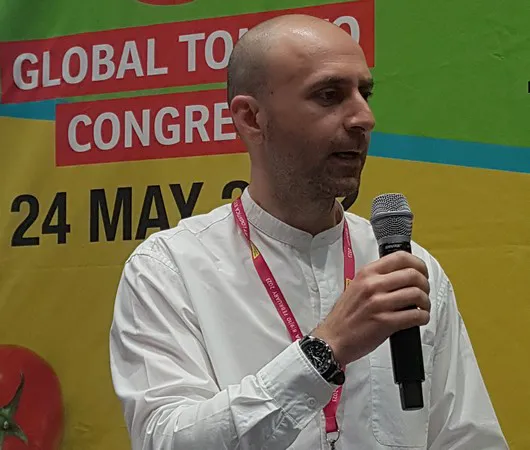At first, herbs and lettuce were the focus at Infarm, but now the indoor farmers, who are currently active in 11 countries, are literally looking up because they are fully committed to growing crops on high wires—starting with tomatoes.

A Vision Paper was published on Wednesday, June 1, and the previous week, Pavlos Kalaitzoglou, Director of Crop Science at the company, also spoke about the company's ambitions at the Global Tomato Congress. "Our herb and lettuce crops are already profitable, and we are looking beyond."
Pavlos said that Infarm's ambition is to grow to the point of being able to harvest 200 kilos of tomatoes per square meter per year. A partnership with Wageningen University & Research announced at the beginning of this year should help with that.
Stepping into tomato production
Not that Infarm isn't already doing its own research. A 'mini-university' was established within the company where, according to Pavlos, many aspects of indoor cultivation are researched. For example, they are looking into crop protection, irrigation, and phenotyping, as well as the cultivation of new crops, especially for indoor farms. Research aimed at growing more types of crops started to be carried out about two and a half years ago. "We have also dared to take the step into tomato production," says Dr. H. H., who is also a member of the WUR.
Through its cooperation with the WUR, Infarm has gained research capacity. To be precise, Infarm is covering the total cost required to complete three interrelated projects over the next four years, funding two PhD students and one postdoc at WUR. The focus of the research is on photoperiod and how much light a crop can maximally handle. Now people often stop at 18 hours, but can the limit be stretched to perhaps even 24 hours?
Lighting
In order to gain insight into this, two projects will investigate how efficiently tomatoes are able to capture and distribute light. This will be done with an innovative 3D scanning procedure. By taking into account the physical properties of the tomatoes, the optimum amount of light, and other factors, Infarm aims to eventually increase tomato production in its cultivation facilities.
As pointed out by Pavlos, it is important to realize that these are adapted varieties. The tomato plants do not grow as fast here as in the greenhouse. That would not be practical in highly automated indoor growing facilities. Currently, Infarm has four varieties of cherry tomatoes that fit well into their cultivation plan. Infarm is also breeding itself, although they are looking for partners to accelerate this process.
Volumes
Initially, Infarm's focus in indoor growing was on food safety, which is still how the company wants to stand out. But the firm also has the capacity to distinguish itself in the area of harvesting. At the moment, the company is harvesting 81 kilos of tomatoes per square meter per year. These are cherry tomatoes. However, Pavlos still sees a lot of growth potential, both in terms of volume, "with the prospect of easily reaching 100 kilos per square meter per year in the next ten years," and in terms of Brix. The Brix now ranges between 9 and 10, which, according to the Director of Crop Science, is "already high."
So there is work to be done for the clever people at Infarm. Challenges include seeking optimal nutrient recipes and irrigation and optimizing the photosynthesis so that the crop can make the best use of the light available. If this is successful, harvesting as much as 200 kilos of cherry tomatoes per square meter per year is possible. "We see no limits. In the course of our own research, we also give our people fifty percent of the time off. They can then do research on things they come up with themselves and test their own ideas. I think that's also why we've come so far."
For more information:
Infarm
www.infarm.com
